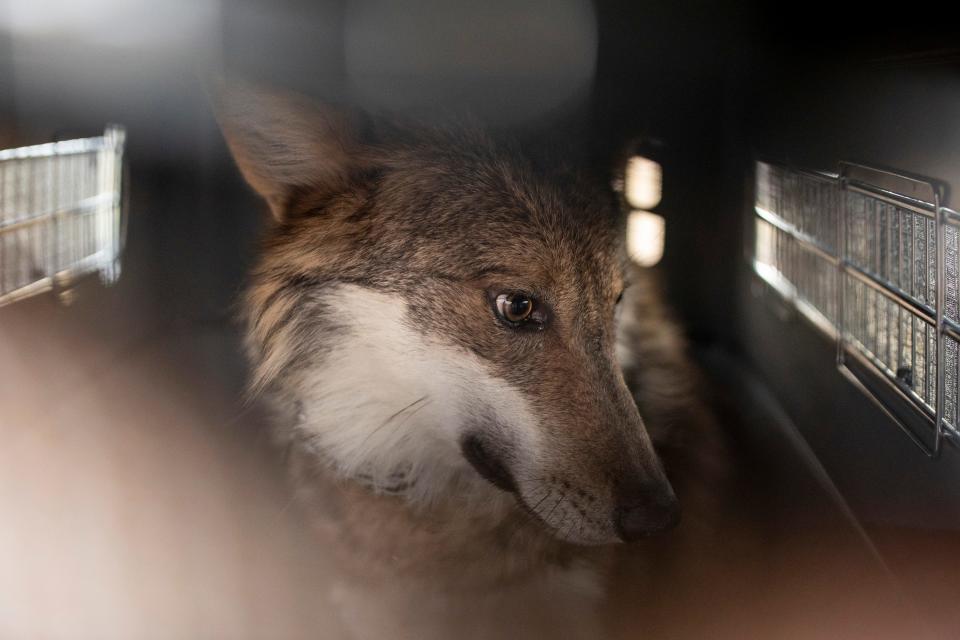'Lobo' numbers increased last year in New Mexico, but concerns remain for its survival
Endangered Mexican gray wolves appeared recovering in New Mexico amid lingering concerns for the population’s genetic long-term surivial in the state’s southwest bootheel region.
Known locally as “lobos,” the wolf was listed as endangered by the U.S. Fish and Wildlife Service in 1976, the highest form of federal protection, and an area designated for its recovery was established in western New Mexico and eastern Arizona.
On Tuesday, the Fish and Wildlife Service announced it record 241 wolves surviving in the area in 2022.
More:Lawsuit demands federal action to save native New Mexico chipmunk from extinction
That’s a 23 percent increase from the 196 wolves documented in 2021.
In New Mexico there were 136 wolves reported, with 105 in Arizona.
The Service reported at least 59 packs – a group of two or more – as of the end of last year, 40 in New Mexico and 19 in Arizona.
There were at least 121 pups born in 2022, the report read, with 81 surviving until the end of the year, marking a 67 percent survival rate compared with the average of 50 percent.
More:Checkerspot butterfly listed as endangered in New Mexico, despite rancher opposition
At least 31 breeding pairs were found, with 20 in New Mexico and 11 in Arizona last year, and 109 collared wolves were in the wild at the end of the year – 45 percent of the wild population.
The Service touted the growth as evidence federal recovery efforts are proving successful.
Stewart Liley, chief of wildlife at the New Mexico Department of Game and Fish said the agency worked closely with the State of Arizona to conserve the species across its two-state range.
More:New Mexico national parks some of the most threatened by oil and gas drilling, study says
“Continued cooperation among the state wildlife agencies of Arizona and New Mexico and the Service is essential for recovery of the Mexican wolf,” Liley said. “As we work toward achieving recovery goals, we continue working to build a strong, cooperative team to manage wolves across the range.”
Gray wolf recovery became controversial in New Mexico as conservation groups in the state questioned breeding practices, they said left the surviving population lacking in genetic diversity.
This is because wolf pups are often released into the wild to join existing packs through a process known as “cross-fostering” as opposed to breeding them in captivity and releasing bonded pairs to form their own packs.
More:Lesser prairie chicken numbers dwindle as federal protections take effect this month
Bonded pairs would better ensure the species’ survival rates, argued Michael Robinson at the Center for Biological Diversity based in Silver City.
“More Mexican gray wolves surviving in 2022 is howling good news,” he said. “But with nearly all southwestern wolves as closely genetically related to each other as siblings, the Fish and Wildlife Service can’t pretend these animals are approaching recovery.”

The Center pointed to the survival of just two of 11 captive-bred wolves released into the wild last year, and only 14 surviving of the 86 released since 2016.
More:Lesser prairie chicken now an endangered species in New Mexico amid industry anxieties
“Celebrating population growth while ignoring genetic stagnation is short-sighted,” Robinson said. “It’s time the agency resumed releasing well-bonded wolf families in which parents are usually successful in keeping pups alive to pass on their precious DNA.”
Chris Smith at Santa Fe-based WildEarth Guardians also pointed to illegal killings of the species by humans, and through government-sanctioned activities.
“This count marks the progress of the last 25 years since wolves were first re-introduced, but there are serious warning signs pointing to a fragile population and inadequate recovery efforts,” Smith said. “We should celebrate that there are 241 lobos, but we will remain vigilant in advocating for their restoration.”
A coalition of conservation groups last fall sued the U.S. Fish and Wildlife Service, questioning its gray wolf recovery plan for an alleged lack of requirements for genetic diversity and protections from human killings.
The suit also argued the Fish and Wildlife Service’s plan unduly restricted the wolf’s habitat from north of Interstate 40 and deemed the U.S. population “non-essential” to the species’ recovery.
“The U.S. Fish and Wildlife Service knows exactly what it needs to do in order to further lobo recovery - a federal court told the agency - but unfortunately they won’t do it without being sued over and over again,” Smith said.
Gray wolf recovery in New Mexico was also challenged by agricultural landowners in the bootheel region, often fearful the predatory species could threaten livestock.
This issue brought outcry from the ranching community in New Mexico last year as the Fish and Wildlife Service removed a population cap on the species.
"The increasing Mexican gray wolf population will increase the number of wolf conflicts. It also increases the burden our state's ranchers are carrying for the Mexican gray wolf reintroduction," said Larry Reagan, president of the New Mexico Farm and Livestock Bureau. "It is essential that federal agencies work with ranchers to minimize the potential for conflict."
Reagan said government agencies should work closely with landowners like those in the agriculture industry to develop conservation plans that don't impede the main economic driver of the region.
He said ranchers should be compensated "fully" for wolf attacks on livestock, and regulators should do more to communicate when animals are released and could pose a risk.
"In many voluntary, incentive-based approaches, farmers and ranchers partner with other stakeholders to conserve wildlife for the enjoyment of the citizens of New Mexico," Reagan said. "New Mexico ranchers continue to face the burden of an increasing population while depredation and support programs fail to make them whole."
Adrian Hedden can be reached at 575-628-5516, achedden@currentargus.com or @AdrianHedden on Twitter.
This article originally appeared on Carlsbad Current-Argus: Mexican gray wolf population increased last year in New Mexico

